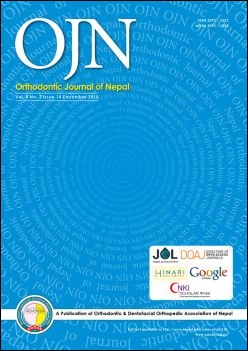Assessment of facial asymmetry and establishment of threshold of sub-clinical asymmetry in Malwa population
DOI:
https://doi.org/10.3126/ojn.v8i2.23068Keywords:
Asymmetry index, Facial asymmetry, Photographic analysisAbstract
Introduction: The word symmetry is derived from the Greek word ‘symmetries’ which means ‘of like measure’. Facial symmetry can be defined in numerous ways, one being associated with the state of facial equilibrium, in which there is a correspondence in size, shape, and arrangement of facial landmarks on the opposite sides.
Materials & Method: The 1427 subjects in the present study were selected from the Out Patient Department of Government College of Dentistry, Indore(M.P), who presented with aesthetically pleasing faces over a period of one year (October 2013-0ctober 2014). Out of the 1427 patients examined 150 (17-30 years) subjects were randomly included. Photographs and orthopantomogram of all the 150 patients were obtained.
Result: The photographs and orthopantomogram were analyzed & Absolute value of Asymmetry Index was taken for all the measurements. Comparison of absolute Asymmetry index of different parameters between male and female subjects was performed. Wilcoxon paired test showed right side predominance for the parameter corpus length, middle facial width, cheek length, lower facial width.
Conclusion: In the present study an attempt was made to quantify sub-clinical asymmetries in clinically symmetrical faces. Minor asymmetries were observed in nearly all individuals taken up for the study. There is no association of gender with predominance of facial asymmetry. On assessment of side predominance of asymmetry it was concluded that the right side dominance of asymmetry for corpus length, middle facial width, cheek length, lower facial width. A threshold value of 6% for sub-clinical asymmetry was established from this study except for condylar and coronoid.
Downloads
Downloads
Published
How to Cite
Issue
Section
License
Copyright © held by Orthodontic & Dentofacial Orthopedic Association of Nepal
- Copyright on any research article is transferred in full to the Orthodontic & Dentofacial Orthopedic Association of Nepal upon publication in the journal. The copyright transfer includes the right to reproduce and distribute the article in any form of reproduction (printing, electronic media or any other form).
- Articles in the Orthodontic Journal of Nepal are Open Access articles published under the Creative Commons CC BY License (https://creativecommons.org/licenses/by/4.0/)
- This license permits use, distribution and reproduction in any medium, provided the original work is properly cited.




